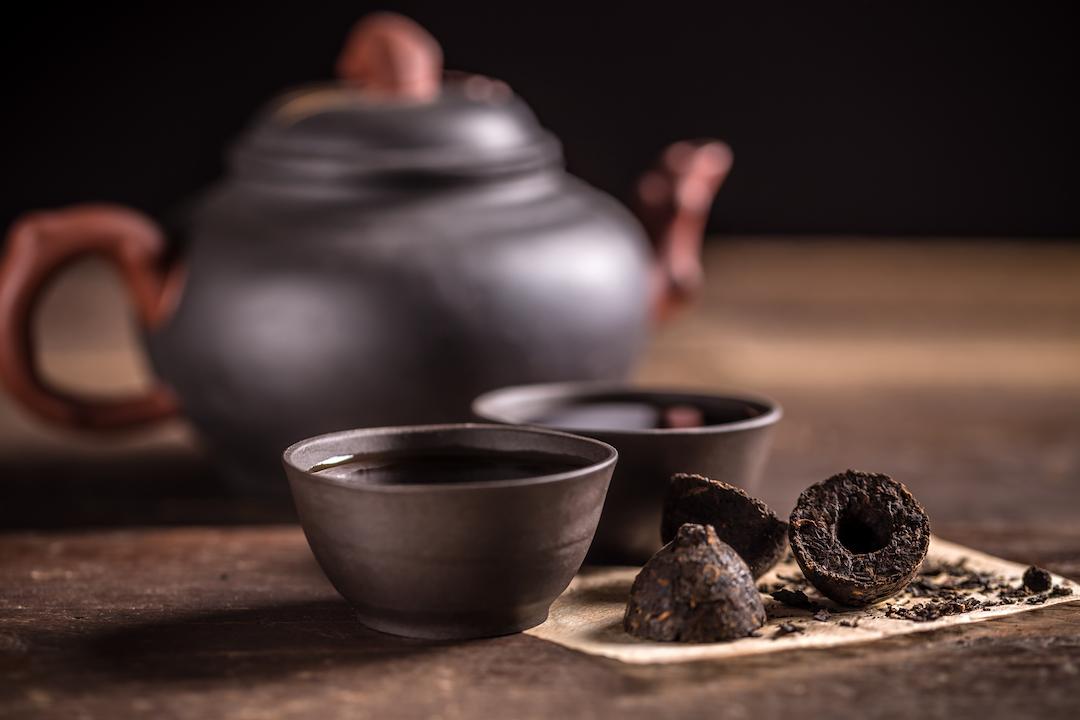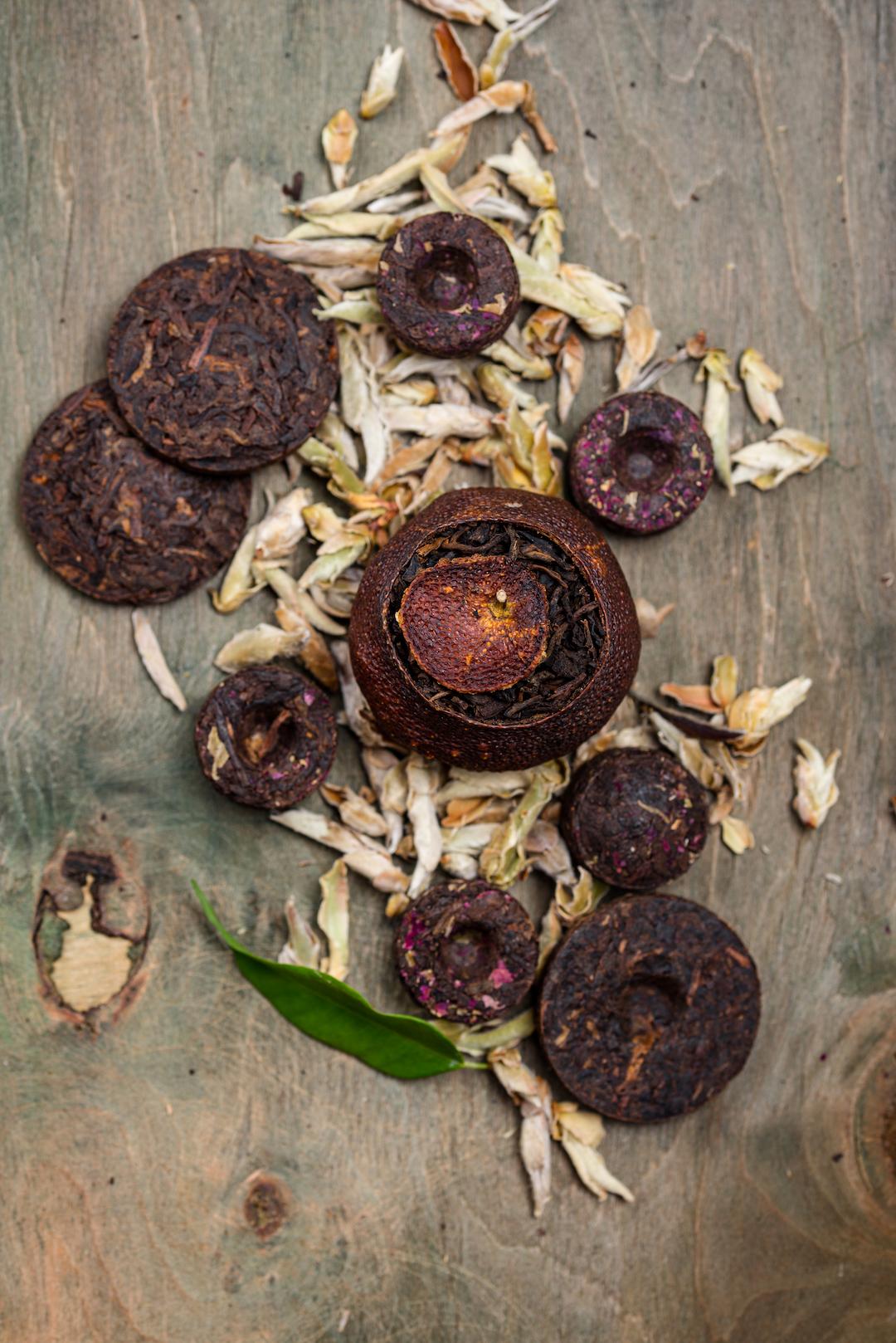Pu-erh Tea: A Chinese Tea Aged To Perfection
Posted by Elise Goldsworthy BHSc (Nutrition Science) on 27th Apr 2022
Pu-erh tea (pron. pu-ayr) is a Chinese tea worth discovering. Pu-erh tea is made from the camellia sinensis plant, just the same as the other ‘true teas’. We know the likes of green, oolong and black tea enjoy plenty of attention from tea-lovers. Yet, pu-erh tea seems to remain slightly unknown. Pu-erh tea is distinctive amongst other classic teas due to the special production methods it undergoes. It has an earthy, pungent flavour with richness and complexity that is unrivalled against other true teas. The qualities it possesses from fermentation give pu-erh tea some specialised health benefits, which aren’t shared by the likes of green or black tea.
So what exactly is pu-erh tea and why is it so special? Let’s take a dive into the world of this unique aged Chinese tea.
History of Pu-erh Tea
Pu’er tea or Pu-erh tea is a type of fermented tea from the Yunnan China province. The name pu-erh is derived from the ancient tea trading region of Pu’er. What makes pu-erh tea so unique is that it's produced using a special microbial fermentation process. This process is either slow over many years or it can be quickened and achieved after several months.
The history of fermented Chinese tea has been ongoing in Southwestern China for centuries. These teas were originally devised to be a cheaper alternative to traditionally made teas. Fermented tea was made available for workers and peasants within the region. Some of the most famous pu-erh tea growing areas in China include the Six Great Tea Mountains. Each of these mountains found in Yunnan are famous for their apt climates and growing conditions, which are perfectly suited to cultivating high quality pu-erh tea. The soil, humidity and surrounding ecology all play a role in the final pu-erh tea that is produced from these mountains.

How Is Pu-erh Tea Made?
Pu-erh tea falls under a separate category of true teas, and in Chinese they are known as ‘dark teas’ (heicha). This is not to be confused with black tea, as it relates to teas that have been specifically fermented and oxidised. There are two subcategories of pu-erh tea. The first type is called sheng (raw) pu-erh and the second is shou (ripe) pu-erh tea.
Raw Pu-erh Tea
Raw pu-erh uses the traditional, slow fermentation and production method. Raw pu-erh tea has a robust, strong flavour with subtle nuances depending on how long the ageing process has been. This tea can be expensive due to the lengthy fermentation process involved. Some of the most exquisite and costly raw pu-erh teas have been aged for up to 50 years.
Ripe Pu-erh Tea
Ripe pu-erh tea uses a modern, accelerated production process. Ripe pu-erh tea can be just as flavoursome at a fraction of the price of its raw tea counterparts. This is because ripe pu-erh tea is produced far quicker than raw pu-erh, and it has a wonderful depth and savoury flavour. There is an undertaking of controlled microbial fermentation with either method. This means the tea will continue to oxidise and ferment in the presence of bacteria and fungi, producing a deep, rich flavour for which pu-erh tea is renowned.
Both of these pu-erh tea categories use a raw product known as maocha (rough tea). Maocha can be sold as is, or pressed into a ball or cake, known as sheng cha (raw tea). Maocha is the unoxidized form of green tea, made from the large leaves of the camellia sinensis plant found exclusively in the southwestern Yunnan mountains. This tea is solely used for the production of pu-erh tea, unlike the smaller types used for green, oolong, black and white teas grown in other regions of China. After the pu-erh tea has reached the desired fermentation level, the leaves are packed and sold either as bricks or as loose leaf teas.
Pu-erh Tea: Aged From Its Environment
Both raw and ripe pu-erh teas can be aged to mature their flavour and aroma. The individual tea’s microbial profile will affect the ageing speed and overall finished quality. The shape and size of the tea will influence how quickly or slowly it will mature. The larger the cake or ball, the faster the tea ages. Other environmental factors will also influence the resulting tea. These include the amount of oxygen exposure, correct storage, humidity, the presence of mould spores, light exposure and moderate temperatures. All of these parameters need to be in perfect balance for the desired outcome and ageing process to occur successfully in pu-erh teas.
Pu-erh teas may also undergo continued maturation as they are stored at home. To do this, simply store in a non-airtight container and label with the date and year of purchase. Otherwise, store your pu-erh tea the same as you would your usual teas in a container away from direct heat and light.

Flavour & Aroma
Raw pu-erh tea has robust and woodsy notes, with a subtle sweetness and rounded finish. This variety of pu-erh tea has a natural richness that is more pronounced with age, much like a good quality wine.
Ripe pu-erh tea is more full-bodied and has a traditional true tea flavour profile. It also has a depth of flavour and earthy aroma that can be enjoyed by most palates.
Because pu-erh tea is made using green and black teas, it will naturally have these underlying flavours. Pu-erh tea leaves themselves are darker and provide an autumnal aroma when brewed. The naturally-occuring caffeine offers a feeling of wakefulness. This tea can be enjoyed throughout the day and early afternoon.
Health Benefits of Pu-erh Tea
Pu-erh tea is a highly treasured tea, boasting unique flavours, aromas and health benefits. There are various phytochemical compounds which offer many advantages to human health. These bioactive polyphenols are present in other teas made from the camellia sinensis plant. These include white, green, black and oolong teas. Commonly found polyphenols in pu-erh tea include flavonoids, phenolic acids, alkaloids, tannins and catechins.
Pu-erh tea possesses extra health-giving properties, likely due to the microbial content from the fermentation process. It’s believed these benefits could be similar to other fermented and probiotic foods, such as sauerkraut and miso paste. Some reported therapeutic benefits of pu-erh tea include:
- Antimicrobial
- Neuroprotective
- Chemoprotective
- Anti-obesity
- Antidiabetic
- Supports digestive health

High In Antioxidants
Pu-erh tea extract was found to be high in superoxide free radicals. This study confirmed the presence of several powerful antioxidant compounds that protect against fibroblast cell damage. Other observed effects included the ability of these compounds to reduce the accumulation of other reactive oxygen species. The authors noted that the overall antioxidant impact of compounds found in pu-erh tea were stronger than those of a typical green tea. The polyphenols responsible for this activity are catechins and epigallocatechin gallate.
The benefits of consuming foods high in antioxidants are widespread for human health. Chiefly, antioxidants work to reduce systemic inflammation. Inflammation that goes unchecked in the body can cause tissue damage, impair neurotransmitter function and disrupt the digestive system. It’s important to include foods and drinks high in antioxidants, such as pu-erh tea to support your body’s overall health.
Protects Against Cancer Growth
A cell study has found that pu-erh tea extract inhibits cancer cell growth and proliferation. According to this research, this phenomenon occurs in a dose-dependent manner. This means that the effects against cancer cells were observed in real time and were heightened with each pu-erh tea administration. Further activity was seen across a 24 hour period against cancer cells. Pu-erh tea extract was effective in halting several processes within the cancer cell cycle.
Antidiabetic Activity
Several studies have shown glucose modulating effects from pu-erh tea. A rat study assessing the hypoglycemic effects of pu-erh tea had some positive results. According to this study, water extract with pu-erh tea significantly increased glucose uptake. Moreover, during a period of 4 weeks, pu-erh tea extract slowed blood insulin and glucose levels. There was also an improvement in glucose tolerance, which led the authors to conclude that pu-erh tea extract has many potent mechanisms by which it improves diabetic symptoms.
How to Brew Pu-Erh Tea
There are two ways to brew your pu-erh tea. One is the modern western method, the other is the traditional Chinese method. The modern method uses familiar brewing tools that most tea-drinkers will have on hand. The traditional method is a lovely, ritualised brewing technique using classic brewing tools, such as a gaiwan. This method is great if you want to experience the historical culture that surrounds pu-erh tea.
However, for most of us, we have the basics for tea making on hand. Here’s how to make a robust and enjoyable pu-erh tea like a true teamaster (the modern way!).
Step 1: Prepare Your Tea Leaves
The typical type of pu-erh tea available is the loose leaf variety. In which case, a teaspoon per person and one for the pot is a good measure for a delicious pu-erh brew.
If, however, you have splurged on a pu-erh brick or cake, simply break off a similar amount per person. Around 1 gram for every 15 ml of water is a general rule for pu-erh brewing.
Step 2: Rinse Your Tea Leaves
It’s important to rinse your tea leaves in hot water before the steeping process. Place the tea leaves in a teapot and add enough hot water to submerge the leaves, then strain away the water. This allows the leaves to unfurl slightly and reveals a smoother, well-rounded flavour in the final cup.
Step 3: Steep Your Tea Leaves
Pu-erh tea can handle a much higher temperature compared to other true teas. Freshly boiled water is ideal and produces the strongest tea with a wonderful depth of flavour. Steep your pu-erh tea for 3-4 minutes in just-boiled water before drinking. Strain as usual and breathe in the robust and earthy aromas. Usually, pu-erh brews yield around two or three servings. Enjoy.
References
Du, W. H., Peng, S. M., Liu, Z. H., Shi, L., Tan, L. F., & Zou, X. Q. (2012). Hypoglycemic effect of the water extract of Pu-erh tea. Journal of agricultural and food chemistry, 60(40), 10126–10132. https://doi.org/10.1021/jf302426w
Huang, Q., Chen, S., Chen, H., Wang, Y., Wang, Y., Hochstetter, D., & Xu, P. (2013). Studies on the bioactivity of aqueous extract of pu-erh tea and its fractions: in vitro antioxidant activity and α-glycosidase inhibitory property, and their effect on postprandial hyperglycemia in diabetic mice. Food and chemical toxicology : an international journal published for the British Industrial Biological Research Association, 53, 75–83. https://doi.org/10.1016/j.fct.2012.11.039
Jie, G., Lin, Z., Zhang, L., Lv, H., He, P., & Zhao, B. (2006). Free radical scavenging effect of Pu-erh tea extracts and their protective effect on oxidative damage in human fibroblast cells. Journal of agricultural and food chemistry, 54(21), 8058–8064. https://doi.org/10.1021/jf061663o
Wang, S., Qiu, Y., Gan, R. Y., & Zhu, F. (2022). Chemical constituents and biological properties of Pu-erh tea. Food research international (Ottawa, Ont.), 154, 110899. https://doi.org/10.1016/j.foodres.2021.110899
Wang, Q., Gong, J., Chisti, Y., & Sirisansaneeyakul, S. (2014). Bioconversion of tea polyphenols to bioactive theabrownins by Aspergillus fumigatus. Biotechnology letters, 36(12), 2515–2522. https://doi.org/10.1007/s10529-014-1632-0
Wikipedia Contributors. (2022, April 20). Pu-erh Tea. Retrieved from Wikipedia website: https://en.wikipedia.org/wiki/Pu%27er_tea, viewed April 20, 2022
Xie, J., Yu, H., Song, S., Fang, C., Wang, X., Bai, Z., Ma, X., Hao, S., Zhao, H. Y., & Sheng, J. (2017). Pu-erh Tea Water Extract Mediates Cell Cycle Arrest and Apoptosis in MDA-MB-231 Human Breast Cancer Cells. Frontiers in pharmacology, 8, 190. https://doi.org/10.3389/fphar.2017.00190
Zhao, L., Jia, S., Tang, W., Sheng, J., & Luo, Y. (2011). Pu-erh tea inhibits tumor cell growth by down-regulating mutant p53. International journal of molecular sciences, 12(11), 7581–7593. https://doi.org/10.3390/ijms12117581
